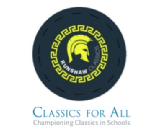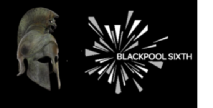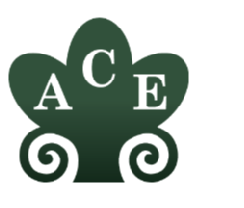Follow the link for the Syllabus Booklet and Workbook and EMACT Greek Tests. Includes Lesson Plans.
Classics for All Recommended Resources GCSE (KS4)
All KS4-5 Latin and Greek
 The Teachers’ section of the ARLT website (free log-in required from ARLT for teachers). This contains a very wide range of teaching materials created by teachers delivering GCSE and A-level language and set text papers, listed under specific authors and in the materials listed by year underneath. NB although set texts change every 2 years, it is worth looking back for previous appearances in earlier years.
The Teachers’ section of the ARLT website (free log-in required from ARLT for teachers). This contains a very wide range of teaching materials created by teachers delivering GCSE and A-level language and set text papers, listed under specific authors and in the materials listed by year underneath. NB although set texts change every 2 years, it is worth looking back for previous appearances in earlier years.
Includes Lesson Plans and information.
KS4 Latin
Language

Welcome to the Cambridge Latin Course! With a 50 year history of development and revision, the Cambridge Latin Course (CLC) has established itself as the leading beginner's course for Latin. In addition, both Eduqas and OCR examination boards endorse the Cambridge Latin Course for GCSE teaching. Aims of the CLC: to teach comprehension of the Latin language for reading purposes; to develop an understanding of the history and culture of Roman civilisation; to encourage a wide range of approaches to language learning through the use of high quality audio-visual resources. Visit the website for more informational and additional resources. Includes Lesson Plans.
KS4 Greek
Language
First written in response to a JACT survey of over 100 schools, and now endorsed by OCR, John Taylor's Greek to GCSE has become a standard resource for students in the UK and for readers across the world who are looking for a clear and thorough introduction to the language of the ancient Greeks. Revised throughout and enhanced by coloured artwork and text features, this edition will support the new OCR specification for Classical Greek (first teaching 2016). Follow the link to access answer-key (login required). Includes Lesson Plans.
 EMACT Greek Certificate: EMACT offers a certificate system for the introduction of ancient Greek via a series of graded test booklets. The EMACT Classical Greek Graded Tests are at 4 levels: Level 1E (Entry) is for non-specialists, can be taken with resources supplied in the booklets and is meant for interested time-strapped groups. Levels 1S/2S/3S (Specialist) are higher levels that presuppose certain amounts of teaching time; these have been successfully taken by groups working outside the timetable.
EMACT Greek Certificate: EMACT offers a certificate system for the introduction of ancient Greek via a series of graded test booklets. The EMACT Classical Greek Graded Tests are at 4 levels: Level 1E (Entry) is for non-specialists, can be taken with resources supplied in the booklets and is meant for interested time-strapped groups. Levels 1S/2S/3S (Specialist) are higher levels that presuppose certain amounts of teaching time; these have been successfully taken by groups working outside the timetable.
Literature
Classics for All - Recordings of Greek GCSE Set Texts
Classics for All has produced these videos for GCSE students studying Ancient Greek who may not have had the opportunity to hear the texts read in the original Greek. With thanks to the A. G. Leventis Foundation for its generous support for Classics for All's Electra programme which works to introduce and develop the teaching of Ancient Greek in state schools.
KS4 Ancient History
The WCN has been working together with Classics for All to create a suite a resources, starting with Ancient History GCSE. This is the first phase of a joint project which has involved the collaboration of a team of academics and teachers across the country, spearheaded by Peter Wright of Blackpool Sixth Form (teacher of the year at the Times Education Supplement Further Educations Awards 2015), with major contributions from Anna McOmish of Aldridge School and Dr Maria Haley of the University of Leeds and Classics for All North, as well as content from Ben Windsor of HASLA, Kirsty Churchill of Cardinal Newman School, and a bit of tweaking and website design by Dr Paul Grigsby of WCN. Includes Lesson Plans.
Dave Midgley and Helen Taylor are Director of Humanities and Head of History respectively at Parrs Wood High School and teach Ancient History at GCSE and A Level. Stupid Ancient History is a series of video/blogs which can be accessed via Youtube or the WCN stoa site. Information.
AIE resources illustrate the relevance of ancient Athenian inscriptions, especially those of the classical period (the fifth and fourth centuries BC, c. 500-300 BC), to pre-18 education in the UK and beyond. They aim to support teachers who wish to introduce inscriptions into their teaching as a way of captivating their students’ imagination and fostering enthusiasm for the ancient Greek world.
These resources, consisting of teachers’ notes and slides for classes, underline the textual and visual potential of inscriptions for those engaged with learning about ancient Greek history and civilisation. The idea of an inscription being carved and read “in real life” is a way of fostering the curiosity of students about the past. Accordingly, through inscriptions, learners benefit from the bringing to life of the ancient world, perhaps in a way that helps it seem less abstract and initially less complicated. At the same time, they hope that introducing students at pre-18 level to inscriptions will encourage them to explore ancient source material of their own accord, and will help them to ‘bridge the gap’ into University study if they chose to pursue it. In their Introduction to AIE for Teachers resource you will find more ideas about using inscriptions in the classroom. They also offer a set of slides which introduce learners of all ages to Greek inscriptions: see Introduction to ancient Athenian inscriptions.
KS4 Classical Civilisation
Myth & Religion
Teaching Myth and Religion – these resources on Teaching Myth and Religion are being developed by by CfA Leic and can currently be accessed by emailing acc-cori@le.ac.uk.
 History Association: an Introduction to Ancient Greek Religion Podcasts + accompanying scheme of work - provides an introduction to some of the key rituals of Ancient Greek religion. The podcasts are for advanced KS2, and KS3 students; Year 13 students (ancient languages) have also successfully used them for background, and they may be helpful in preparation for OCR A Level Classical Civilisation (H408/31) Greek Religion. The scheme of work is aimed at advanced KS2, and KS3 students. Includes Lesson Plans.
History Association: an Introduction to Ancient Greek Religion Podcasts + accompanying scheme of work - provides an introduction to some of the key rituals of Ancient Greek religion. The podcasts are for advanced KS2, and KS3 students; Year 13 students (ancient languages) have also successfully used them for background, and they may be helpful in preparation for OCR A Level Classical Civilisation (H408/31) Greek Religion. The scheme of work is aimed at advanced KS2, and KS3 students. Includes Lesson Plans.
AIE resources illustrate the relevance of ancient Athenian inscriptions, especially those of the classical period (the fifth and fourth centuries BC, c. 500-300 BC), to pre-18 education in the UK and beyond. They aim to support teachers who wish to introduce inscriptions into their teaching as a way of captivating their students’ imagination and fostering enthusiasm for the ancient Greek world.
These resources, consisting of teachers’ notes and slides for classes, underline the textual and visual potential of inscriptions for those engaged with learning about ancient Greek history and civilisation. The idea of an inscription being carved and read “in real life” is a way of fostering the curiosity of students about the past. Accordingly, through inscriptions, learners benefit from the bringing to life of the ancient world, perhaps in a way that helps it seem less abstract and initially less complicated. At the same time, they hope that introducing students at pre-18 level to inscriptions will encourage them to explore ancient source material of their own accord, and will help them to ‘bridge the gap’ into University study if they chose to pursue it. In their Introduction to AIE for Teachers resource you will find more ideas about using inscriptions in the classroom. They also offer a set of slides which introduce learners of all ages to Greek inscriptions: see Introduction to ancient Athenian inscriptions.
 Myth and Religion Prescribed Visual/Material Sources GCSE videos. Francesca Grilli from Runshaw College has created an amazing set of videos and allowed us to use them as part of the WCN/Classics for All resource collaboration. Francesca is Course Leader for Classics at Runshaw College in Leyland. For more info about Runshaw Classics follow them on Twitter @RunshawClassics, Instagram, or subscribe to their Youtube Channel. The videos have content relevant to the study of Myth and Religion at GCSE and include some of the prescribed visual and material sources for OCR Class Civ GCSE. Information.
Myth and Religion Prescribed Visual/Material Sources GCSE videos. Francesca Grilli from Runshaw College has created an amazing set of videos and allowed us to use them as part of the WCN/Classics for All resource collaboration. Francesca is Course Leader for Classics at Runshaw College in Leyland. For more info about Runshaw Classics follow them on Twitter @RunshawClassics, Instagram, or subscribe to their Youtube Channel. The videos have content relevant to the study of Myth and Religion at GCSE and include some of the prescribed visual and material sources for OCR Class Civ GCSE. Information.
The British School at Athens (BSA) have created a Resource Pack for GCSE Class Civ Myth and Religion, collecting together a unique collection of images that come from the Archive of the BSA. The BSA is a research institute founded in 1886 that leads, co-ordinates and facilitates research in Greece and the surrounding lands. Much of this work is archaeological, and the BSA has been at the forefront of many important archaeological discoveries over the last 130 years. Follow the link to explore this online treasure and to discover more about Greek myth and religion as the evidence was uncovered. Information.
Prescribed Visual/Material Sources - Videos. Peter Wright of Blackpool Sixth has created some videos in his inimitable style (check out the music) for the Myth and Religion module.
You can find out more about Ancient History at Blackpool Sixth through their Twitter, and check out Peter's own Twitter account and Youtube Channel for more content. Information.
 Ara Pacis and Augustus available on the Teachers’ section of the ARLT website (free log-in required from ARLT for teachers).
Ara Pacis and Augustus available on the Teachers’ section of the ARLT website (free log-in required from ARLT for teachers).
Info.
Women in the Ancient World
Stupid Ancient History. Dave Midgley and Helen Taylor are Director of Humanities and Head of History respectively at Parrs Wood High School and teach Ancient History at GCSE and A Level. Stupid Ancient History is a series of video/blogs which can be accessed via Youtube or the WCN stoa site. These include videos on Cleopatra. Information.
The Homeric World
Teaching Homeric World – these resources on Teaching The Homeric World are being developed by by CfA Leic and can currently be accessed by emailing acc-cori@le.ac.uk.
The British School at Athens (BSA) have created a video archive of lectures which will be of interest to those studying classics and ancient history. The following lectures were recorded by the British School at Athens in both Athens and London, as part of our academic lecture programmes. These presentations document new research and new ideas. Some of these ideas are currently unpublished. Although the lectures were not given with the school syllabus in mind, they have been organised here by module, to provide ‘extension’ activities and additional material for interested students. The information in these lectures can be used when students are required to make reference to recent scholarship. Information.
Roman City Life
 Romans in focus is a series of free five-minute videos that take a closer look at what life was really like under the Roman empire, from displays of power under Augustus, to identity and life as a soldier stationed in northern Britain. Each of the eight topics aims to explore and examine those who were often invisible in Latin literature, and to challenge and debate some of our most common misconceptions about these people and their lives. Information and downloadable PDFs.
Romans in focus is a series of free five-minute videos that take a closer look at what life was really like under the Roman empire, from displays of power under Augustus, to identity and life as a soldier stationed in northern Britain. Each of the eight topics aims to explore and examine those who were often invisible in Latin literature, and to challenge and debate some of our most common misconceptions about these people and their lives. Information and downloadable PDFs.
Ancient Rome Live - A free educational learning platform including short videos on topics related to Ancient Rome, including people, monuments, important places, historic dates, museums and exhibits, and cities of the Roman Empire. Also now offering free online seminars. Info.
War & Warfare
As part of their Classical Civilisation Teachers’ Summer School, held at King’s College London, ACE has prepared a series of introductory talks, delivered by leading academics and tailored specifically for the GCSE and AS/A-level Classical Civilisation syllabi. These include a talk on War and Warfare.
The resources here are divided according to syllabus, but you can find the complete teacher resources from ACE and their Class Civ Teachers events via this link. You can find out more about the remarkable work of ACE on their dedicated website. Information.










